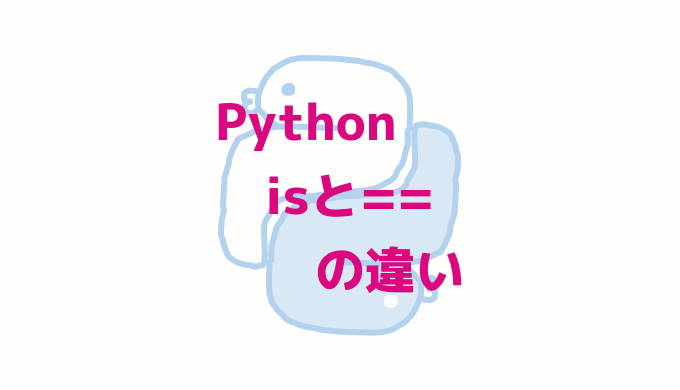isは同一性の比較==は等価性(同値性)の比較
を行います。
目次
Python Version
Python 3.9.0
is

オブジェクト同士がメモリー内で同一の箇所を参照している場合Trueになります。
参照箇所の識別子はid()を使用すると取得できます。
サンプルコード
下準備
class Hoge:
def __init__(self, name):
self.name = name
hoge1 = Hoge('hoge')
hoge2 = hoge1
hoge3 = Hoge('hoge')
id()を使用して参照箇所の識別子を確認してみる
print(f'hoge1のid = {id(hoge1)}')
print(f'hoge2のid = {id(hoge2)}')
print(f'hoge3のid = {id(hoge3)}')
実行結果
hoge1とhoge2が同一箇所を指している
hoge1のid = 1532449598288
hoge2のid = 1532449598288
hoge3のid = 1532449598480
isと==の判定結果を確認してみる
print(f'hoge1 is hoge2 → {hoge1 is hoge2}')
print(f'hoge1 is hoge3 → {hoge1 is hoge3}')
print(f'hoge1 == hoge2 → {hoge1 == hoge2}')
print(f'hoge1 == hoge3 → {hoge1 == hoge3}')
実行結果
同一のメモリの箇所を参照していたhoge1とhoge2のisはTrueを示し、==の判定結果もTrueになっている
hoge1 is hoge2 → True
hoge1 is hoge3 → False
hoge1 == hoge2 → True
hoge1 == hoge3 → False
==

オブジェクトのクラスの__eq__()メソッドでTrueと判定される場合Trueになります。
サンプルコード
下準備
__eq__メソッドを実装
hoge1とhoge3はどちらもnameをhogeに設定
class Hoge:
def __init__(self, name):
self.name = name
def __eq__(self, other):
if type(self) is not type(other):
return False
return self.__dict__ == other.__dict__
hoge1 = Hoge('hoge')
hoge2 = hoge1
hoge3 = Hoge('hoge')
isと==の判定結果を確認してみる
print(f'hoge1 is hoge2 → {hoge1 is hoge2}')
print(f'hoge1 is hoge3 → {hoge1 is hoge3}')
print(f'hoge1 == hoge2 → {hoge1 == hoge2}')
print(f'hoge1 == hoge3 → {hoge1 == hoge3}')
実行結果
hoge1とhoge3は異なるオブジェクトなのでisの判定結果はFalseだが、nameが同じなので__eq__メソッドでTrueとなり、==の判定結果もTrueとなっている
hoge1 is hoge2 → True
hoge1 is hoge3 → False
hoge1 == hoge2 → True
hoge1 == hoge3 → True



[…] [Python]isと==の違いとは? […]